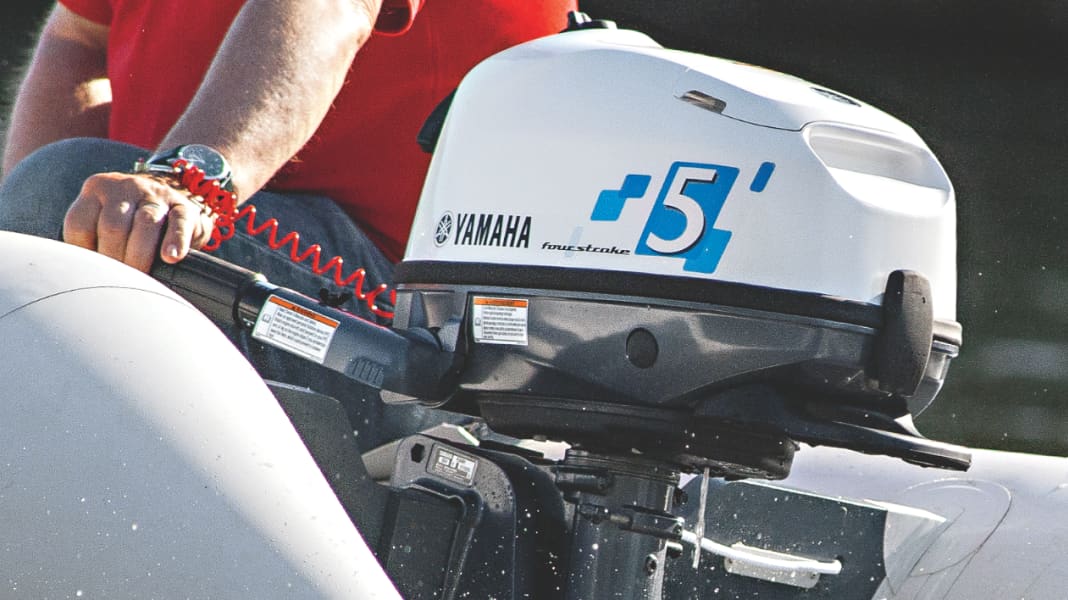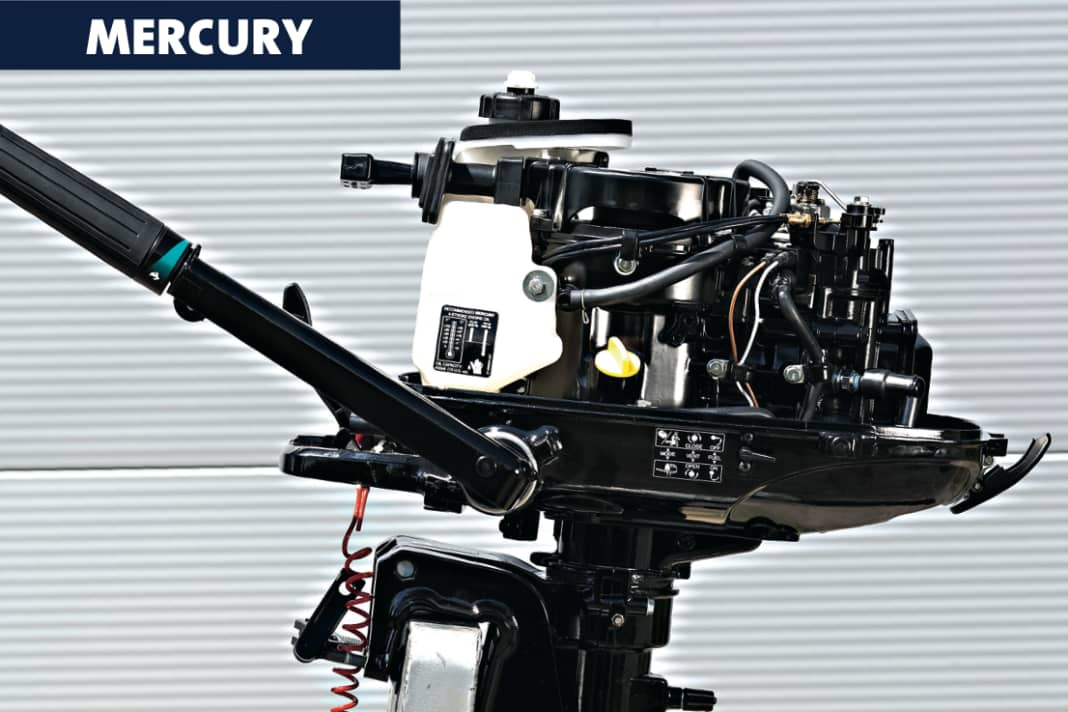






It was obvious," say those who knew it beforehand. For those who don't want to join in the swan song for the 5 Series after the new driving licence regulations, the attendance list in this comparison test is a huge disappointment.
Selva, a big name at least in terms of name, has once again left the BOOTE testers' invitation unanswered. The same applies to Parsun, who wanted to shake up the market with inexpensive Yamaha oldies made in China. It was probably nothing! Initially there was also silence from Honda. The cancellation with the justification "We won't make the best list with our 5 Series anyway" only came on day 1 of the test week and only after a telephone enquiry.
This raises the question: after having to relinquish the title of "most powerful licence-free engine" to the 15cc at the end of last year, is the 5 hp class becoming a wallflower? The answer is no. A 5 hp outboard weighs only half as much as a 15 and is therefore much easier to mount on the emergency transom or stow in the forecastle. This makes it the ideal dinghy or reserve motor. Of course, you can do more with a 15 hp motor (see test in BOOTE 10/12), but the fun is about twice as expensive.
Convinced of the capabilities of their engines and the sales figures, the candidates Mercury, Suzuki, Tohatsu and Yamaha take on the challenges of a comparison test. A selection of propellers, a manual starting device and a shaft with a length of 381 mm are required, as both are a perfect match for the test boat, a Grand Corvette C 360 (boat test in BOOTE 7/13). - If you study the technical data, you will find exactly the same values for Mercury and Tohatsu, with the exception of weight and price. This must be the case, as both are launched with almost identical engines.
The equipment of the engines
The principle of equality, which applies to all test engines, also applies to the design and equipment of the four-stroke petrol engines. The members of the test quartet only have one cylinder, a carburettor with a manual cold-start device (choke button), electronic ignition, an integrated plastic fuel tank and a gearbox that can be divided into "forward", "neutral" and "reverse".
a gearbox that can be shifted into "forward", "neutral" and "reverse". Water/single-circuit cooling, a propeller, flat-water trim position and the plug-in connection for an external tank are also standard. The charging coil that supplies the power for the navigation lights, on the other hand, is always an extra on the five-man models that are only available as manual starters.
On the subject of security
The start lock, which prevents the engine from being started with a gear engaged, and the emergency stop switch (quick stop), without which the engine stops immediately or does not start at all, and whose pull cord should always be "on the man" (wrist, leg or belt loop) during the journey, are a must. The fact that none of the tested quickstops floats is a source of annoyance at the latest when the line and appendage have gone overboard and the engine can therefore no longer be started. - "False start", or rather "no start", is also the keyword behind the shift lock on the test engines. If it existed, it would prevent the transmission from shifting at high speeds. That would be good for the transmission and for safety.
The latter can also suffer from the lack of on-board tools on the Yamaha. What should you do if the manual starter gives up the ghost and cannot be removed without tools? The supplied emergency starter rope alone is of little help. The test competition has much more to offer in this respect, Mercury and Tohatsu even include a spare spark plug. Multilingual (German is always included) and well-illustrated manuals provide information on how best to use the tools, rope and spark plug in an emergency, how to change the mini disposable fuel filters and how to operate the engines correctly and safely in practice.
The weight
If you put the engines on the scales ready to go (with engine oil, fuel and propeller), the indicator stops at 28.6 kg (Yamaha) at the latest. Only the Tohatsu remains under the 27 kg mark. Those who are able to grip the boat firmly will have no problem with these weights, either during assembly or when going ashore, thanks to the sufficiently large and well-rounded transport handles. Unfortunately, thieves will only have a problem if a sturdy padlock is hooked into the toggle bolts. If the motor should get loose during the journey, you are on the safe side with a safety line - an eyelet for this is standard everywhere.
In contrast to the price, where the difference between expensive (Suzuki) and cheap (Mercury) is just 81 euros, there are clear differences in the warranty periods. The Mercury is also top of the class here, with a warranty period that only ends after five years. The test competition ends two years earlier.
The inflatable practice test rig, the Grand 360, is 3.60 metres long and weighs 78 kg when fitted with a wooden shelf.
The performance values
In other words, if you include the driver, motor and test equipment, the test candidates have to move around 200 kg. Equipped with the right propeller (full load speed in the upper third of the manufacturer's recommendation) and correctly trimmed (there is a bolt that can be set to five or six different positions), this is no problem for any of the test engines. They all glide effortlessly. Effortless means "without crawling forwards and without an endless transition phase".
The best sprinters are Tohatsu (23.9 km/h) and Mercury (23.4 km/h), with Suzuki and Yamaha trailing behind. The most economical and comfortable gliding speed is 15 km/h. If you only have a little more than a litre of fuel with you, you have to use it sparingly. Nobody can do this as well as the fast Tohatsu. In other words, its 0.08 l/km is the best mark in this test and gives it a range of 13.8 km. The test competition landed just behind with 0.09 l/km. The fact that the Suzuki clearly outperforms all competitors in terms of range (16.7 km) is solely due to the fact that it has the largest (1.5 litre) tank. The Yamaha is the downward outlier here, running out of breath, or rather fuel, after just 8.5 km at full load.
The noise development
Comfort is not only defined in this test primarily by the noise level and smooth running. If you take the values measured in gliding speed and the sound as a yardstick, the test winner in this point is Suzuki. Mercury and Tohatsu are louder under full load and sound rougher overall. Yamaha's 5 Series is also not a quiet performer and annoys the driver in the lower speed range (up to 10 km/h) with clearly noticeable vibrations in the tiller.
The test quartet has to prove its qualities as an emergency engine on a Rio 580, a 5.80 m long and 1200 kg heavy cabin cruiser. The fact that a propeller with a low pitch and large diameter is an advantage is shown by the results of the Mercury, which, although all manufacturers were informed about this test task, is the only one to offer a genuine pusher propeller in its range of test propellers. The result: The Rio reaches 7.5 km/h in current-free water, stops very quickly and changes direction of rotation (reversing) effortlessly when docking forwards and backwards.
The bollard pull
The bollard pull, the electronically measured tractive force, documents the strength of the Mercury at 61 kilonewtons (kN). The Suzuki comes closest, with the same manoeuvring characteristics, but is slightly slower (7.1 km/h) and not quite as powerful (57 kN). Tohatsu and Yamaha seem noticeably strained when manoeuvring with the Rio, which is expressed less in the volume than in the propeller ventilation. At a speed of 6.6 km/h, just ahead of the Yamaha, the Tohatsu shows clear weaknesses in bollard pull. This means that at 48 kN it comes in a distant fourth behind the Yamaha, which pulls 55 kN on the scales. It remains to be said that the reason for the more or less noticeable propeller ventilation on all engines is solely to be found in the height of the Rio's emergency transom.
The handling
When it comes to handling, the first thing that impresses is the good starting behaviour of the engines. If you use the choke correctly, i.e. only when the engine is cold, there is no strenuous pulling of the starter rope and no clouds of smoke. When steering and accelerating, the motto is "take it easy": the ease of movement of the folding tiller and the handy twist grips can be adjusted. Only the Suzuki and Yamaha hand levers mounted on the right-hand side of the engine are convincing when it comes to gear shifting. They are easy to reach and can be moved easily and precisely. The only criticism levelled at the front-mounted levers from Mercury and Tohatsu is aimed at the short shift travel: they allow you to shift (too) quickly past the neutral position when starting up.
Conclusion: The test quartet impresses with compact dimensions and weights, easy handling and sufficient safety, and therefore fulfils the most important requirements placed on a dinghy and/or reserve motor. The Suzuki is the tester's favourite. It is not the number 1 in terms of price and warranty, but offers the most complete package in terms of smooth running, ease of use, economy, range and pulling power.
Overall package. Second, but anything but second choice, is Tohatsu's MFS 5 CS, which is fast, light and economical and only shows clear weaknesses when shifting gears and "pulling poles". The price and range of propellers speak in favour of the identical and only slightly slower Mercury, making it the test leader in bollard pull. The biggest advantage of the Yamaha is its ease of use. The fact that it only came fourth in this test is due to the sum of vibration, fuel consumption, weight, speed and the not exactly ample pulling power.

